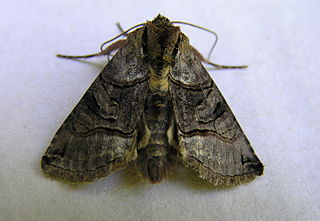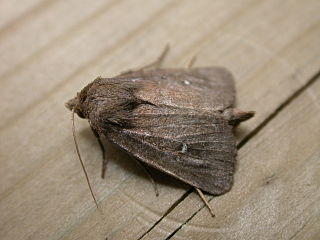
Noctuoidea is the superfamily of noctuid or "owlet" moths, and has more than 70,000 described species, the largest number of any Lepidopteran superfamily. Its classification has not yet reached a satisfactory or stable state. Since the end of the 20th century, increasing availability of molecular phylogenetic data for this hugely successful radiation has led to several competing proposals for a taxonomic arrangement that correctly represents the relationships between the major lineages.

Abrostola tripartita is a moth of the family Noctuidae. It is found throughout much of the Palearctic realm including all Europe, Russia, Siberia Amur, Kyrgyzstan, and Kazakhstan.
Tolpia is a genus of moths of the family Erebidae erected by Francis Walker in 1863. The genus used to be included in the family Noctuidae.

Lenisa is a monotypic moth genus of the family Noctuidae erected by Michael Fibiger, Alberto Zilli and László Aladár Ronkay in 2005. Its only species, Lenisa geminipuncta, was first described by Adrian Hardy Haworth in 1809. It is found in southern and central Europe, Lebanon, Israel, Turkey, Iraq and in the Caucasus. Some authors place this genus name as a synonym Archanara, and the species as Archanara geminipuncta.
The Micronoctuini are a tribe of moths in the family Erebidae that includes about 400 described species. Typical species in the tribe have bifine hindwing venation and are smaller than those in other noctuoid moths. Micronoctua karsholti is the smallest of all species in the superfamily Noctuoidea.
The Micronoctuina are a subtribe of moths of the family Erebidae erected by Michael Fibiger in 2005.
The Tactusina are a subtribe of moths of the family Erebidae. The clade was described by Michael Fibiger in 2010.
Bellulia is a genus of moths of the family Erebidae. The genus was erected by Michael Fibiger in 2008.
Parachrostia is a genus of moths of the family Erebidae erected by Michael Fibiger in 2008.
Tactusa is a genus of moths of the family Erebidae. The genus was erected by Michael Fibiger in 2010.
Fustius is a genus of moths of the family Erebidae erected by Michael Fibiger in 2011.
Parens occi is a moth of the family Erebidae first described by Michael Fibiger and Vladimir S. Kononenko in 2008. It is known from the southern part of the Russian Far East to central, eastern and northeastern China, North Korea, South Korea, and Jeju Island. In Japan, it is known from the Tsushima Islands in the Korean Strait and Honshu.
The Tentaxina are a subtribe of moths of the family Erebidae. The clade was described by Michael Fibiger in 2011.
Parens is a genus of moths of the family Erebidae erected by Michael Fibiger in 2011.
Tentaspina is a genus of moths of the family Erebidae. The genus was erected by Michael Fibiger in 2011.
Tentax is a genus of moths of the family Erebidae. The genus was erected by Michael Fibiger in 2011.
Flax is a genus of moths of the family Erebidae. It was described by Michael Fibiger in 2011.
Medius is a genus of moths of the family Erebidae erected by Michael Fibiger in 2011.
Sternitta is a genus of moths of the family Erebidae erected by Michael Fibiger in 2011.
Dorsum is a genus of moths of the family Erebidae erected by Michael Fibiger in 2011.


